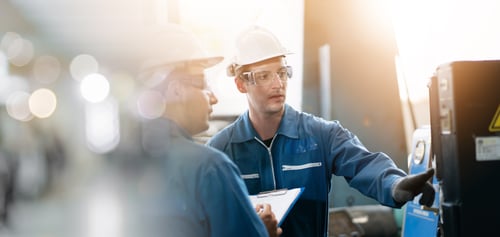Hardfacing and How to Grind It
Hardfacing is a critical process in extending the life and performance of industrial components. It involves applying a layer of tough, wear-resistant material build-up to the surface of metal parts or equipment to protect it from wear and tear. This technique is particularly valuable in industries like mining, construction, agriculture, and manufacturing, where equipment durability is paramount.

Hardfacing Alloys and Their Properties
The choice of hardfacing alloys is vast, with each offering different properties to combat wear. Commonly used materials include:
-
High-Carbon Steels: These are used for their abrasion resistance and are effective against low-stress scratching wear.
-
Chromium Carbide: Known for its high hardness and wear resistance, it's ideal for resisting severe abrasion and moderate impact.
-
Nickel-Base Alloys: These alloys provide excellent corrosion resistance and heat resistance, suitable for environments with chemical exposure.
-
Tungsten Carbide: Offers exceptional hardness and wear resistance, making it ideal for high-abrasion and high-impact conditions.
These alloys are selected based on the type of wear they need to withstand, such as abrasion, impact, heat, or a combination of factors.
Hardfacing Processes
The application of hardfacing material can be achieved through various welding processes, each suitable for different types of base materials and wear conditions:
-
Shielded Metal Arc Welding (SMAW): Also known as stick welding, it's versatile and widely used for its simplicity and cost-effectiveness.
-
Gas Metal Arc Welding (GMAW/MIG): Offers high deposition rates and efficiency, suitable for both thick and thin sections.
-
Flux-Cored Arc Welding (FCAW): Combines the benefits of SMAW and GMAW, providing flexibility and deep penetration.
-
Submerged Arc Welding (SAW): Ideal for large areas requiring high deposition rates, used in controlled environments for optimal results.
Preparation for Hardfacing
Proper preparation is crucial for a successful hardfacing application. This includes:
-
Surface Cleaning: Removing all contaminants like oil, dirt, and rust to ensure a strong bond.
-
Material Selection: Matching the hardfacing alloy to the base metal and wear conditions.
-
Preheat and Interpass Temperatures: Controlling temperatures to prevent cracking and ensure proper metallurgical bonding.
Grinding of Hardfaced Materials
Grinding hardfaced materials is challenging due to their toughness and abrasiveness. Diamond grinding wheels are preferred to traditional machining processes for their superior hardness and durability. Key considerations include:
-
Grit Size: Selecting the right grit size is crucial for balancing material removal rates and achieving the desired surface finish.
-
Wheel Bond: The bond type (resin, vitrified, metal, or electroplated) affects the wheel's wear rate, cutting efficiency, and lifespan.
-
Wheel Configuration: Shape and size should be chosen based on the grinding task to access the workpiece effectively without compromising performance.
Selection of Diamond Wheels for Hardfacing
Choosing the right diamond wheel involves considering:
-
Material Hardness: Harder materials require diamond wheels with a higher concentration of diamond grit.
-
Surface Finish Requirements: Finer grits are used for a smoother finish, while coarser grits are better for rapid material removal.
-
Coolant Use: Proper coolant application is essential to prevent overheating and to maximize wheel life and grinding efficiency.
Grinding Techniques and Best Practices
Effective grinding requires:
-
Optimal Speed and Feed Rate: These should be adjusted to avoid overheating and to ensure efficient material removal.
-
Coolant Flow: Adequate coolant flow cools the wheel and workpiece, removes swarf, and prevents clogging and overheating.
-
Regular Wheel Dressing: Maintaining wheel sharpness and shape ensures consistent grinding performance and prevents defects.
Maintenance and Safety in Grinding
Regular maintenance and adherence to safety protocols are vital. This includes:
-
Wheel Inspection and Dressing: Regular checks and dressing of the wheel maintain its condition and performance.
-
Training and Protective Gear: Operators should be well-trained and equipped with appropriate safety gear to handle diamond wheels safely, especially when grinding hardfaced materials.
![]()
Hardfacing and grinding of hardfaced materials are intricate processes that require careful selection of materials, tools, and techniques. By understanding the intricacies of hardfacing alloys and diamond wheel grinding, industries can enhance the durability and performance of their components, leading to improved efficiency and reduced downtime. The right approach to hardfacing and grinding not only extends the service life of equipment but also ensures optimal functionality and wear resistance in demanding industrial environments.
Recent Posts
Subscribe to email updates
Subscribe to our blog to get the latest updates from the experts on Grinding Wheels! You can easily unsubscribe at any time


